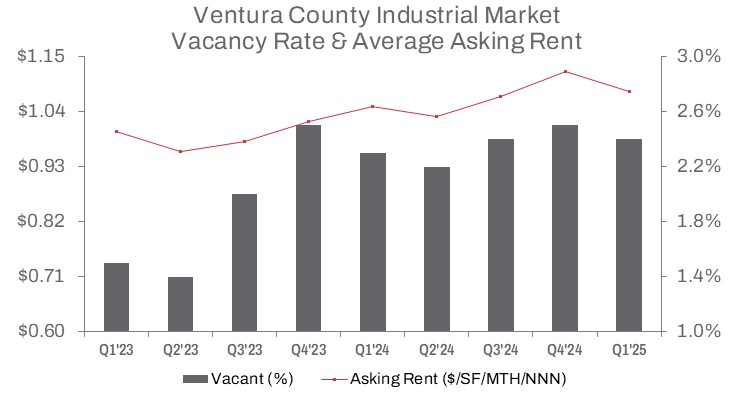First Quarter 2025
Ventura County Industrial Market Cools with Elevated Vacancy and Cautious Development
Low vacancy rates persist despite softening demand, as limited construction and high borrowing costs shape a cautious market outlook.
Although the vacancy rate is expected to rise, it will remain low due to limited speculative construction.

MARKET OVERVIEW
In Q1 2025, Ventura County’s industrial market saw a 4.5% quarter-over-quarter decrease and a 6.8% year-over-year increase in vacant space, driven by fluctuating demand for warehouse-distribution facilities and an uptick in available inventory. While the vacancy rate rose by 10 basis points year-over-year, it remained relatively low at 2.4%. Rents continued to fluctuate, increasing 2.9% year-over-year but declining by 4 cents from the prior quarter to reach $1.08 per square foot on a triple net basis.
Vacant sublease activity also grew significantly. By the end of Q1, total vacant sublease space reached 145,780 square feet—up 33.4% quarter-over-quarter and a staggering 140% year-over-year. Despite signs of a cooling rental market, low vacancies persist, largely due to limited new construction. Still, industrial development ticked up—rising 7.6% from the prior quarter and 29.3% year-over-year—with 328,807 square feet under construction as of Q1 2025.
Q1 2025 leasing volume totaled 232,325 square feet, while overall space availability climbed to approximately 1.95 million square feet—up 0.6% from Q4 2024 and 12.3% higher than in Q1 2024. A decline in demand for warehouse space has tempered developer confidence, driven by high interest rates, rising construction costs, and ongoing economic uncertainty.
The easing shortage of industrial space overall contrasts with the continued scarcity of large, modern warehouse-distribution centers. These facilities remain constrained due to limited speculative construction. Although e-commerce growth has cooled since its pandemic-era surge, demand for industrial space remains steady, particularly for well-priced last-mile distribution facilities.
Elevated borrowing costs and a lack of motivated sellers contributed to a 76.7% year-over-year drop in sales volume, with just 91,604 square feet sold. This reflects a broader market trend of cautious investment activity amid rising costs and economic headwinds.
TRENDS TO WATCH
Although the vacancy rate is expected to rise, it will remain low due to limited speculative construction. The market is projected to experience a leveling of rent and sale prices. While demand has softened, businesses seeking large, state-of-the-art facilities continue to face limited options. Elevated interest rates have further slowed industrial property sales, adding to the cautious market sentiment.
In Central Ventura County, leasing volume increased 24.7% year-to-date compared to 2024; however, it declined 6.6% from the previous quarter, with only 67,550 square feet leased. Sales volume in the submarket saw a sharp increase, more than tripling from the prior quarter after no sales were recorded during the same period last year. The vacancy rate inched up to 3.1% this quarter—30 basis points higher year-over-year.
In North Ventura County, leasing volume rose 4.3% year-over-year, accompanied by a 30.6% increase in square footage sold. The vacancy rate climbed 110 basis points year-over-year to 3.5%.
Meanwhile, West Ventura County—the largest submarket in the region—posted the lowest vacancy rate at 1.6%. However, combined leasing and sales activity fell 59.3% year-over-year, with no recorded sale activity in Q1 2024 or 2025.
Across Ventura County overall, leasing volume declined 13.6% year-to-date, while total square footage sold rose fourfold, albeit from a low base. Developers remain cautious, as rising availability of industrial space, high construction costs, and elevated interest rates continue to hinder new development.
For tenants considering purchasing industrial space, elevated borrowing costs demand careful financial planning. While rising interest rates may suppress sales activity, constrained inventory levels are expected to support average sale prices. In today’s limited construction environment, leasing remains the prevailing trend—a dynamic likely to influence pricing for warehouse-distribution space into the second half of 2025.


































































